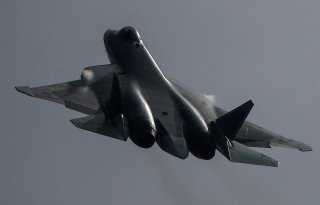Turkey Wants to Build a Fifth-Generation Stealth Fighter Jet (Will Russia Help?)
Turkey has distinguished itself over the years as a reliable importer of high-end Russian military hardware even in the face of vigorous opposition from its NATO partners, but a joint production venture on something as complex as a next-generation fighter is a whole different matter.
Director of Russia’s Federal Service for Military-Technical Cooperation Dmitry Shugayev announced on Wednesday that Moscow and Ankara are in talks over possible joint ventures concerning Turkey’s upcoming TF-X fighter. "At this stage, consultations are underway with the Turkish side at the level of specialized groups on the issues of interaction in creating the Turkish national fighter," he said.
"In this regard, there are interesting areas where we could render technological assistance, considering the experience that our specialists possess in developing and manufacturing aircraft. And we are ready to share our expertise with our Turkish partners. But it is premature to talk about any specific details at this stage," Shugayev added.
As implied by Shugayev, these talks are still in their early stages and could progress in any number of ways. The most ambitious outcome would be a joint production venture along the lines of the ill-fated Russian-Indian FGFA project to build a derivative of Russia's Su-57 stealth fighter. Nevertheless, there is currently no indication that either Moscow or Ankara is interested in a joint venture on this level. Turkey has distinguished itself over the years as a reliable importer of high-end Russian military hardware even in the face of vigorous opposition from its NATO partners, but a joint production venture on something as complex as a next-generation fighter is a whole different matter. The abortive FGFA project is a reminder that, aside from the many technical challenges normally associated with building high-end modern hardware, joint ventures of this kind introduce a whole new universe of legal-diplomatic challenges; the two sides must navigate delicate questions of ownership rights, domestic politics, foreign policy concerns, intellectual property protections, and funding.
If these talks are to yield any concrete results, the likelier outcome would be a technology transfer agreement involving the sale of Russian components, provision of technical assistance from Russian engineers and other specialists, or both. A technology transfer deal of this kind has loomed in the backdrop of Russian-Turkish defense relations for years, as this is not the first time that Russia’s defense industry has signaled its interest in the TF-X project. In 2018, Russian industrial giant Rostec extended its interest in cooperating with Turkey on the TF-X project. Russian manufacturers announced that they are ready to provide engine technology for the new fighter, an offer that Turkish officials said they would consider.
The TF-X is a twin-engine, stealth air superiority fighter, slated to phase out Turkey’s aging stock of F-16 Fighting Falcons. From a smart cockpit to a powerful active electronically scanned array (AESA) radar and extensive datalink capabilities with nearby friendly units, the TF-X bears all the staple features of a fifth-generation fighter.
Tempting as it is to view Turkey's new fighter in this light given Ankara’s recent ejection from Lockheed Martin’s partner program, the TF-X is not intended to serve as an F-35 Lightning II replacement; if anything, the two fighters complement one another to a significant degree. Rather, the TF-X’s projected capabilities appear to be more in line with the F-22 Raptor. Primarily armed with a complement of new air-to-air missiles from Turkey’s indigenous GÖKTUĞ program, the TF-X is meant to excel in an air superiority role whilst providing secondary precision strike capability with its wide selection of guided bombs from the HGK and KGK series.
The TF-X is projected to make its maiden flight by 2026 and to enter service into the 2030s.
Mark Episkopos is a national security reporter for the National Interest.
Image: Reuters

